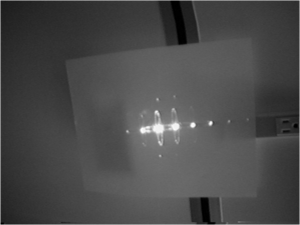Koch Lab:Research/AOD tidbits: Difference between revisions
No edit summary |
|||
| Line 3: | Line 3: | ||
==[[/Detector Wiggle Disaster|Wiggles caused by AOD on the quadrant photodiode]]== | ==[[/Detector Wiggle Disaster|Wiggles caused by AOD on the quadrant photodiode]]== | ||
[[Image:Detector Wiggles for Various AOD Powers.png|right|thumb|wiggles]] | [[Image:Detector Wiggles for Various AOD Powers.png|right|thumb|wiggles]] | ||
After aligning the optical tweezers (at Cornell, Wanglab, see [[Koch_Lab:Publications]] 2002 Biophys J article) Steve, Richard and others discovered that using our AOD to steer the optical trap in the sample plane produces huge "wiggles" on the detector. These wiggles could add as much as 10 nm of error into the detection signal, which was unacceptable. Steve studied the hell out of this for over a month and in the end, use of the AODs for other than intensity modulation was abandonded, and the piezo stage was used for 1-D stretching. Many unpublished things were discovered along the way, which could be useful to other optical tweezers labs or others using AODs. | After aligning the optical tweezers (at Cornell, Wanglab, see [[Koch_Lab:Publications]] 2002 Biophys J article) Steve, Richard and others discovered that using our AOD to steer the optical trap in the sample plane produces huge "wiggles" on the detector. These wiggles could add as much as 10 nm of error into the detection signal, which was unacceptable. Steve studied the hell out of this for over a month and in the end, use of the AODs for other than intensity modulation was abandonded, and the piezo stage was used for 1-D stretching. Many unpublished things were discovered along the way, which could be useful to other optical tweezers labs or others using AODs. Some of our thoughts: | ||
* Wiggles definitely caused by AOD and a repeatable function of frequency and AOD power | |||
* Wiggles perhaps worse due to imaging of AOD onto detector (many labs image a plane between the AODs, which may temper the wiggle problem) | |||
* A wiggle subtraction array can be used, level of success unknown (Steve et al. used an "offset array" subtraction, which accounts for the wiggles at a fixed frequency, variable AOD power). | |||
* Wiggles are probably not in focus in sample plane and so do not affect the trapping force...so a separate detection beam probably negates wiggles problem. | |||
<br style="clear:both;"/> | <br style="clear:both;"/> | ||
Revision as of 22:54, 19 June 2007
During grad school, Steve spent a bunch of time monkeying around with AODs (acousto-optic deflectors, see: wikipedia:AOM) during the construction of otpical tweezers. He spent sometimes months over-analyzing some of the problems encountered and accumulated a lot of data that hasn't been published. He'd like to put that data on OWW to save time for others who may encounter those problems.Send Steve a note if you would like more information about these things--a note will make him motivated to post things sooner!
Wiggles caused by AOD on the quadrant photodiode

After aligning the optical tweezers (at Cornell, Wanglab, see Koch_Lab:Publications 2002 Biophys J article) Steve, Richard and others discovered that using our AOD to steer the optical trap in the sample plane produces huge "wiggles" on the detector. These wiggles could add as much as 10 nm of error into the detection signal, which was unacceptable. Steve studied the hell out of this for over a month and in the end, use of the AODs for other than intensity modulation was abandonded, and the piezo stage was used for 1-D stretching. Many unpublished things were discovered along the way, which could be useful to other optical tweezers labs or others using AODs. Some of our thoughts:
- Wiggles definitely caused by AOD and a repeatable function of frequency and AOD power
- Wiggles perhaps worse due to imaging of AOD onto detector (many labs image a plane between the AODs, which may temper the wiggle problem)
- A wiggle subtraction array can be used, level of success unknown (Steve et al. used an "offset array" subtraction, which accounts for the wiggles at a fixed frequency, variable AOD power).
- Wiggles are probably not in focus in sample plane and so do not affect the trapping force...so a separate detection beam probably negates wiggles problem.
Amazing diffraction patterns caused by acousto-optic effects
Schaefer-Bergmann diffraction? Possible the root cause of the AOD cross-hatching and detector wiggles?

Crosshatching in laser caused by AOD

